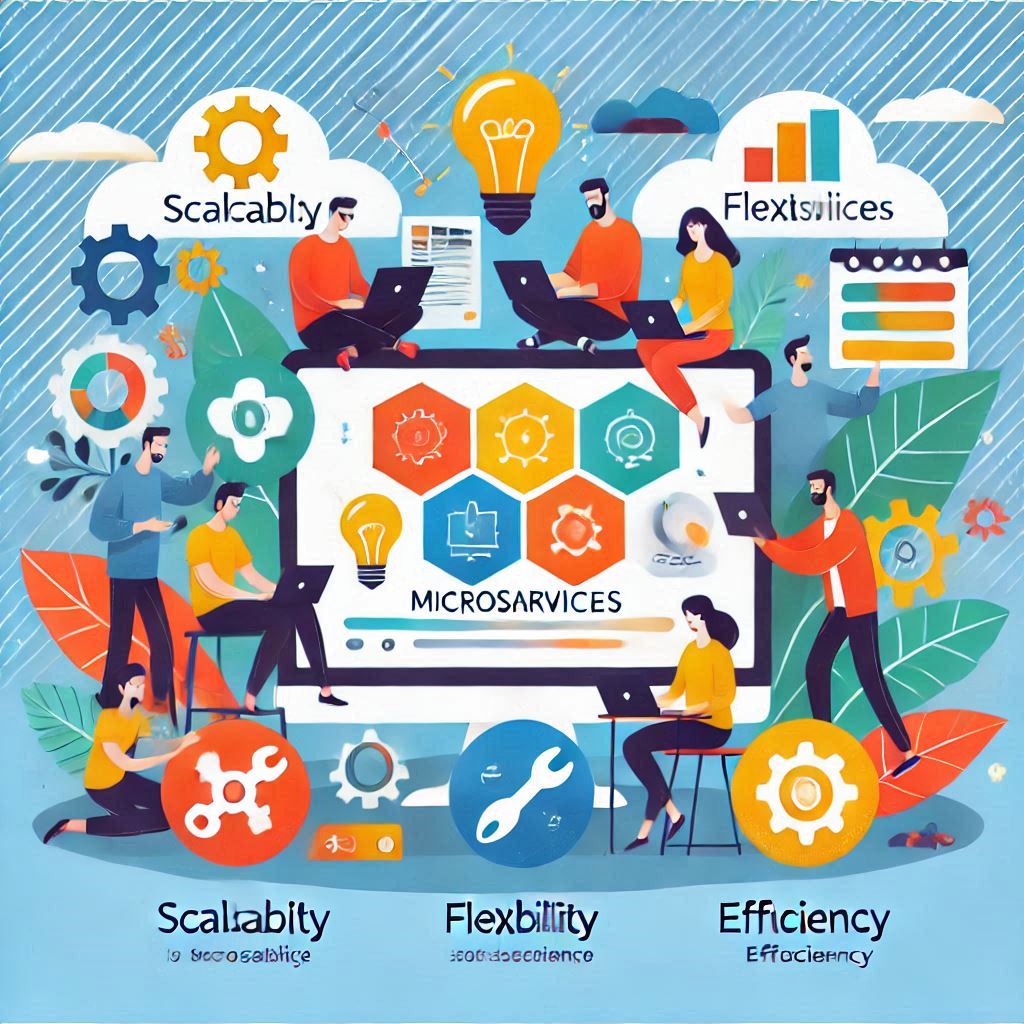Containerization and Microservices: The Future of Scalable Software Architecture – Best 2025
Containerization and Microservices: The Future of Scalable Software Architecture
Containerization and Microservices: The Future of Scalable Software Architecture: In the ever-evolving landscape of software development, two paradigms have emerged as cornerstones for creating scalable software deployment using containers: containerization and microservices architecture. These methodologies have revolutionized how software is developed, deployed, and maintained, offering unmatched efficiency and adaptability across diverse environments. This article delves deep into these technologies, exploring how they are shaping the future of software architecture with microservices and why businesses and developers must embrace them.
Understanding Containerization in Software Development
Containerization is a lightweight form of virtualization that allows developers to bundle an application with all its dependencies—libraries, binaries, and configuration files—into a self-contained unit known as a container.
Key Features of Containerization: Containerization and Microservices
- Portability: Containers ensure that an application runs seamlessly across different environments—development, testing, and production—without compatibility issues.
- Efficiency: With minimal overhead compared to VMs, containers use system resources efficiently.
- Scalability: Containers can be easily replicated, allowing developers to scale applications up or down based on demand.
Popular Containerization Tools: Containerization and Microservices
- Docker: A household name in containerization, Docker simplifies the creation, deployment, and management of containers.
- Kubernetes: This orchestration tool manages clusters of containers, automating tasks like scaling and load balancing.
- Podman: A rootless container engine gaining popularity for its enhanced security model.
Why Use Containerization?
Containerization in software development is pivotal for businesses aiming to streamline scalable software deployment using containers while ensuring consistency and scalability. Whether you’re running applications on a developer’s laptop or deploying them to a cloud environment, containers guarantee uniform behavior.
What is Microservices Architecture?
The microservices architecture approach involves breaking down a monolithic application into a collection of small, loosely coupled services that communicate over a network.
Benefits of Microservices:
- Scalability: Individual microservices can be scaled based on their usage, optimizing resources.
- Flexibility: Teams can develop, deploy, and maintain services independently, enabling faster iteration cycles.
- Fault Isolation: A failure in one service does not cascade to the entire system, enhancing reliability.
- Technology Agnosticism: Different microservices can use different programming languages, frameworks, and databases as per their needs.
Examples of Microservices in Software Development:
- E-commerce platforms: Services like inventory management, payment processing, and user authentication operate independently.
- Streaming platforms: Components like recommendation engines, content delivery, and subscription management are decoupled.
How Containerization and Microservices Work Together

The synergy between containerization and microservices architecture is transforming modern software development. Containers provide the ideal environment for deploying microservices by isolating them, ensuring consistency, and enabling efficient scaling.
Key Advantages of Combining Containerization with Microservices:
- Simplified Deployment: Containers encapsulate each microservice with its dependencies, removing deployment complexities.
- Enhanced Resource Management: With orchestration tools like Kubernetes orchestration for microservices, microservices in containers can dynamically scale based on demand.
- Cross-Environment Consistency: Containers ensure that microservices behave identically across different environments.
- Faster Time-to-Market: Developers can focus on individual services without worrying about the overall application, leading to quicker releases.
The Benefits of Microservices in Software Development
1. Improved Agility – Containerization and Microservices
In traditional monolithic architectures, any change often requires rebuilding and redeploying the entire application. Microservices architecture allows teams to make changes to individual services without disrupting the system.
2. Enhanced Collaboration – Containerization and Microservices
Microservices architecture aligns well with agile and DevOps practices. Teams can work on different services simultaneously, fostering collaboration and reducing development cycles.
3. Seamless Integration with DevOps – Containerization and Microservices
DevOps strategies for managing microservices in containers share a common philosophy of iterative development, automation, and continuous delivery. Microservices architecture complements CI/CD pipelines by enabling the frequent release of small, manageable updates.
4. Cost Efficiency – Containerization and Microservices
Scaling only the services that experience high demand minimizes unnecessary resource usage, optimizing operational costs.

Software Deployment with Containers: Best Practices

- Adopt Orchestration Tools
Use orchestration platforms like Kubernetes orchestration for microservices to automate container deployment, scaling, and management. These tools simplify the handling of large-scale microservices. - Implement CI/CD Pipelines
Automate the build, testing, and deployment of containers. Tools like Jenkins, GitLab CI/CD, and CircleCI are essential for streamlining software deployment with containers. - Ensure Security
Secure container images by scanning for vulnerabilities. Implement role-based access controls and limit privileges to enhance security. - Leverage Monitoring and Logging
Use tools like Prometheus and Grafana for real-time monitoring and logging of containerized applications. This ensures visibility into the system’s performance and health.
Challenges and Solutions in Adopting Containerization and Microservices
1. Increased Complexity
While microservices architecture and containers simplify scaling and deployment, they introduce architectural complexity. Managing inter-service communication, data consistency, and orchestration can be challenging.
Solution: Use service meshes like Istio to manage communication and ensure observability in microservices.
2. Cultural Shift – Containerization and Microservices
Organizations transitioning from monolithic architectures may face resistance to change.
Solution: Invest in training and gradually phase in microservices and containerization to ease the transition.
3. Monitoring and Debugging – Containerization and Microservices
Debugging issues in a distributed system of containers and microservices can be daunting.
Solution: Implement distributed tracing tools like Jaeger or Zipkin to track requests across services.
Real-World Use Cases of Containerization and Microservices
1. Netflix
Netflix adopted microservices architecture to handle its massive user base and dynamic content requirements. With thousands of microservices running in containers, Netflix ensures high availability and scalability.
2. Spotify
Spotify uses microservices to manage features like playlist management and music streaming. Containers ensure these services run consistently across environments.
3. Amazon
Amazon’s shift from a monolithic architecture to microservices helped it scale operations and improve its deployment speed.
4. Financial Services
Banks and financial institutions are leveraging containerized microservices to build modular systems for payment processing, fraud detection, and real-time analytics. Containers’ portability makes it easier to deploy sensitive applications across hybrid cloud environments.
5. Healthcare
Healthcare organizations are using containerized microservices to enable interoperability between systems, ensuring patient records, diagnostics, and billing information are accessible securely across platforms.
Implementation Guide for Beginners – Containerization and Microservices
For organizations new to containerization and microservices architecture, here is a step-by-step guide:
Step 1: Understand Your Requirements
Identify the key components of your application that can be broken into microservices. Focus on business capabilities and critical functionalities.
Step 2: Choose Your Tools
Select a containerization platform like Docker and an orchestration tool like Kubernetes. Ensure your team is familiar with these tools before proceeding.
Step 3: Build and Test Containers
Use Dockerfiles to create container images for each service. Test these containers locally to ensure they function as expected.
Step 4: Deploy to a Development Environment
Set up a development cluster using Kubernetes.
Step 5: Implement CI/CD Pipelines
Integrate CI/CD tools to automate the building, testing, and deployment of your containers.
Step 6: Monitor and Iterate
Use monitoring tools to track application performance and identify bottlenecks. Continuously iterate and improve the architecture based on feedback.
FAQs and Common Misconceptions – Containerization and Microservices
1. Are microservices and containers the same thing?
No. Microservices architecture is an approach to designing software applications as a collection of independent services, while containerization is a technology used to package and deploy these services.
2. Do microservices always require containers?
Not necessarily. While containers are the most common way to deploy microservices, they can also run on virtual machines or bare metal. Containers, however, provide added benefits like portability and scalability.
3. Are microservices only for large-scale applications?
No. While they’re highly beneficial for large-scale applications, smaller projects can also leverage microservices architecture for faster development and easier maintenance.
4. Is it expensive to adopt containerization and microservices?
Initially, there may be costs associated with training, tools, and restructuring. However, the long-term benefits—like scalability, efficiency, and reduced downtime—outweigh these expenses.
5. Can I transition from monolithic to microservices gradually?
Yes. A phased approach is often recommended. Start by identifying key components that can be isolated and transitioned into microservices, and iterate over time.
6. Do containers guarantee security?
While containers provide isolation, they’re not inherently secure. Best practices—like using trusted images, scanning for vulnerabilities, and implementing network security measures—are essential.
7. Are Kubernetes and Docker competitors?
They often complement each other in managing containerized applications.
8. Is debugging harder in microservices?
Debugging can be more challenging in distributed systems, but tools like Jaeger, Zipkin, and centralized logging frameworks simplify the process.
9. Can legacy applications use containers?
Yes, though some refactoring might be required. Containers can help modernize legacy applications by isolating dependencies and improving deployment workflows.
10. How do I ensure consistent performance across environments?
Containers ensure consistency by packaging all dependencies with the application. Additionally, using orchestration tools like Kubernetes helps maintain performance standards.
The Future of Software Architecture – Containerization and Microservices

The adoption of containerization and microservices architecture is set to accelerate as businesses demand scalable software deployment using containers. Emerging trends include:
1. Serverless Computing
Serverless platforms, which automatically manage infrastructure, complement microservices by allowing developers to focus solely on code.
2. Edge Computing
With the rise of IoT and edge devices, microservices in containers are being deployed closer to the user for reduced latency.
3. AI-Driven Orchestration
Artificial intelligence is being integrated into orchestration tools to predict scaling needs and optimize resource allocation.
Conclusion – Containerization and Microservices
Containerization and microservices are undoubtedly shaping the future of software architecture with microservices. Their ability to create scalable, flexible, and efficient systems has made them indispensable in modern software development. By adopting these methodologies, organizations can accelerate innovation, reduce costs, and remain competitive in a rapidly changing technological landscape.
For developers and businesses alike, the time to embrace containerization in software development and the benefits of microservices is now. By leveraging these powerful tools, the future of software architecture can be built on a foundation of resilience, agility, and scalability.
Here are some long-tail keywords based on the article topic and focus:
For Containerization:
- What is containerization in software development?
- Benefits of using containers for software deployment
- Best tools for containerization in 2025
- How to use Docker for microservices
- Containerization vs virtualization for developers
- Simplifying software deployment with containers
- Container orchestration with Kubernetes for scalable systems
- Challenges of containerization in large-scale software projects
- Secure software deployment with containerized applications
- How containerization improves cross-environment software consistency
For Microservices:
- How microservices architecture improves scalability
- Advantages of microservices for agile development teams
- Implementing microservices in e-commerce platforms
- Microservices vs monolithic architecture: Pros and cons
- Best practices for deploying microservices with Kubernetes
- Examples of microservices architecture in real-world applications
- How to manage inter-service communication in microservices
- Microservices architecture for cloud-based applications
- Top tools for debugging distributed microservices systems
- Why microservices architecture is the future of software development
Combined Topics (Containerization + Microservices):
- How containerization supports microservices architecture
- Deploying microservices with containers: A step-by-step guide
- Benefits of combining microservices and containerization
- Scalable software solutions with microservices in containers
- Challenges in adopting containerized microservices systems
- Orchestration tools for containerized microservices architecture
- How to secure containerized microservices environments
- Using Kubernetes for microservices deployment and scaling
- Future trends in containerized microservices architecture
- Building flexible software systems with microservices and containers
These long-tail keywords align with the article content and can help attract a targeted audience interested in containerization, microservices, and modern software development techniques.
General Keywords:
- Future of software architecture with microservices
- How containerization improves software development workflows
- Scalable software deployment using containers
- Microservices and containers for digital transformation
- Best practices for microservices adoption in enterprises
Containerization-Specific Keywords:
- Top containerization tools for developers in 2025
- Advantages of Docker vs Kubernetes for containerized apps
- How containerization helps in hybrid cloud environments
- Container security best practices for modern applications
- Why businesses are adopting containerization in DevOps
Microservices-Specific Keywords:
- How microservices architecture enhances agility
- Microservices use cases in e-commerce and SaaS
- Scaling microservices with Kubernetes auto-scaling
- Challenges of microservices architecture and how to overcome them
- API management strategies for microservices communication
SEO-Optimized Long-Tail Keywords:
- Step-by-step guide to deploying microservices with Docker
- Container orchestration tools comparison for beginners
- Benefits of microservices in software development companies
- How to secure containerized microservices applications
- What is service mesh, and why is it essential for microservices?
Trending Industry Keywords:
- Cloud-native development with containerization and microservices
- DevOps strategies for managing microservices in containers
- Containerized microservices for edge computing solutions
- AI-driven orchestration for Kubernetes environments
- Containerization and microservices for continuous delivery
Viral and Buzzworthy Keywords:
- Why Netflix, Spotify, and Amazon use microservices architecture
- 10 real-world examples of containerized microservices success
- Top microservices trends for scalable software in 2025
- How Kubernetes transforms microservices deployment strategies
- Why containerization is the backbone of modern DevOps practices


